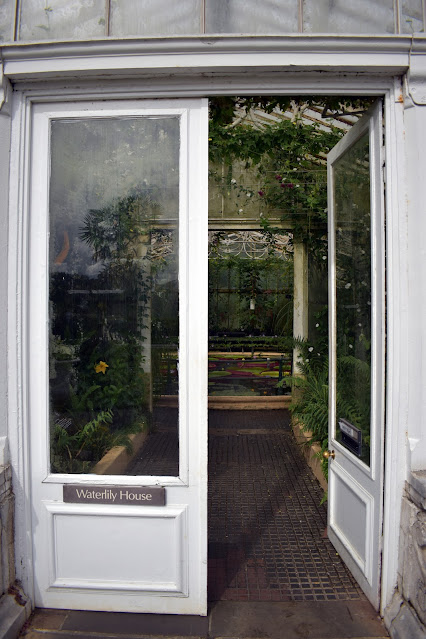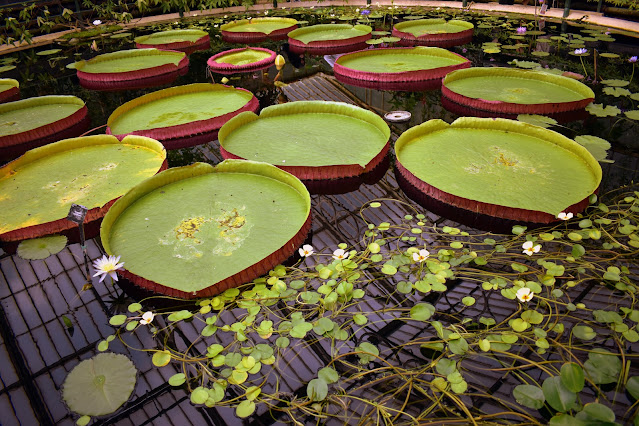From the second I stepped into the Waterlily House at Kew Gardens in London I was filled with awe and wonder. I was both excited and calmed by the environment. It is amazing and I truly love being here.
Kew gardens is based in Kew near Richmond in south London. The Waterlily House is one of the smaller glasshouses at Kew, finished in 1852 and now a listed building.
This glasshouse was designed specifically to showcase the amazing giant Amazon waterlily, (Victoria amazonica) which is a natural wonder and deservedly so.
Experiencing The Waterlily House
Do not be fooled by the Waterlily House unassuming entrance. It belies the beautiful experience you are about to have. As you enter you are immediately greeted with a vibrant array of tropical and aquatic plants including waterlilies and climbers and everything in between, each one a thing of beauty, interest and sheer joy.
When you enter the Water Lily house you are straight away struck by the beauty, then the humidity. In fact it is the hottest and most humid of the glasshouses and it feels like it. You are transported into a different world.
Measuring only 225 square metres or 738 square feet, the small glasshouse heats up very quickly and especially when the weather outside is warm and sunny, so if you visit be prepared for that. Layers you can take on and off quickly as you go in and out of the glasshouses are your friend at Kew Gardens.
The atmosphere inside emotionally is a mixture of silent awe and excited chatter. When we were there a group of schoolchildren were happily taking photographs and calling to each other to look here and there at the plants. It was heart warming to see them so interested and enthralled.
Couples were wandering through smiling at the plants and each other. Others were intent on reading the descriptions of the plants and looking up more details on their phones. Some stood silently gazing. From time to time complete strangers would meet, both looking at a plant and strike up a natural friendly conversation.
For our time in there everyone had one focus and one joy and it was wonderful.
The Pond and Giant Waterlily
At his heart is the circular pond where the giant waterlilies live. This spans over 10 metres or about 32 feet and takes up a large central area of the house. There is a perimeter circular pathway all around and more plants around the perimeter and hanging above our heads. As you walk around you brush against the plants and are able to touch and smell them. The pathway is not large so there is a lot of "excuse me" and smiling as we move past each other. We are all surrounded by gorgeous, interesting plants and immersed in nature.
Some of the waterlilies are almost purely circular while others to me seemed to have a heart shape, all are stunning. We found the giant Waterlily Victoria boliviana in the pond, it is very easy to spot! This is a record breaking waterlily, named as a new species by Kew Gardens in 2022. The lily pads of this species grow up to three metres or about ten feet wide so they are huge and very impressive indeed. They have very wide rims upturned and prickly undersides.
They have beautiful large fragrant flowers which open white and mature to a pretty pink. Gorgeous as they are, each flower only lasts for 2 days. It is truly an amazing sight to behold. We are not permitted to touch these waterlilies but to see them is a privilege.
Giant waterlilies were discovered in Bolivia in 1801 and later on named "Victoria" to honour Queen Victoria Of The United Kingdom. They understandably attracted a lot of attention and curiosity. The huge lily pads look spectacular and grow so massive they are able to carry an adult. However this is most certainly not permitted at Kew and is an offence as can harm the plant and would eventually ruin this most beautiful display of waterlilies. These days only Kew Garden staff are allowed into the pond.
It is also interesting that In the mid-19th century, a specimen of the waterlily was sent to Joseph Paxton, the architect. He designed Crystal Palace in south London which housed the Great Exhibition of 1851. It is said that the waterlily leaf inspired his design for that amazing building. Sadly fire destroyed Crystal Palace 30th November 1936.
Plants In The Waterlily House
While everyone is naturally focussed on the amazing giant waterlilies do take time to look around at the other plants.
While the Waterlilies are the stars here, every star needs a good supporting cast and these plants do that very well. In fact many of these beauties made my heart skip a beat as much as the waterlilies.
There are many beautiful and fascinating plants around the perimeter that are certainly worth taking a while to view and photograph. They add to the beautiful ambiance and magical quality of this lovely place. If I could visit every week I really would! The Waterlily House is open during the Spring, Summer and Autumn up to November then closed for the winter.
People often ask how long will a visit take and I find that difficult to answer. Certainly as one of the smaller glasshouses you can take it all in quite quickly. In ten minutes you can walk all around at a slow pace. However if you do that you are missing the best part of the experience which is to immerse yourself in the plants, see the giant waterlilies and then as you are there longer start to notice all the other details you initially missed.
We were there around an hour and really I still felt I could have stayed longer. So my suggestion is to take your time, wander round, take photos, read the information if you want but do take time to stop and stare, drink in the atmosphere and fully experience it. If you like gardens you may enjoy the book Royal Gardens Of The World which explores twenty one celebrated, beautiful, interesting gardens.
If you love the look of Kew gardens you may like this lovely book The Story Of Kew Gardens In Photographs.
So if you ever visit London's Kew gardens do not miss the Waterlily House, it is a real treat and somewhere we go every time we are able to visit Kew Gardens. For me it is a gardening jewel.



































